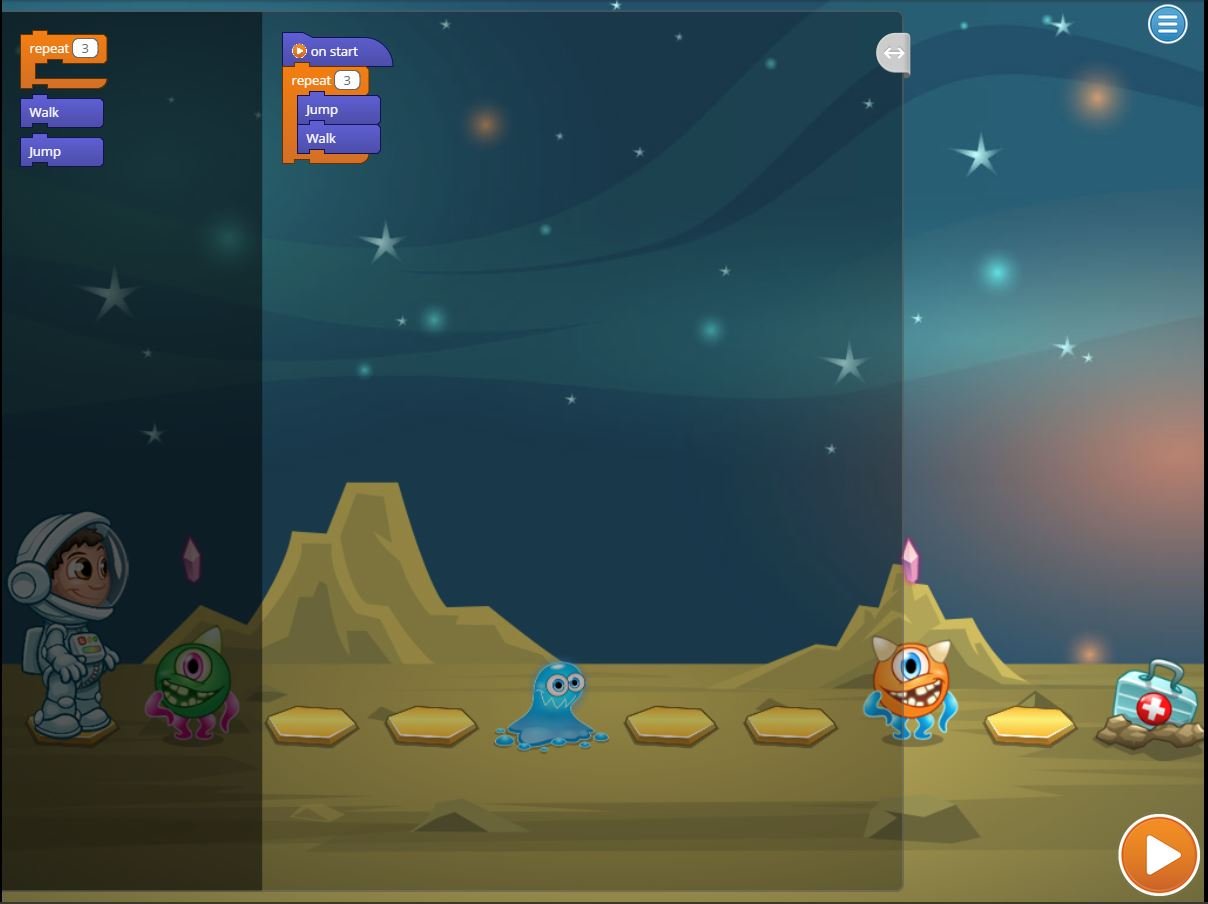Answer Key
Module 4: Collect the tablet

Module 5: Avoid obstacles

Module 6: Detect the pattern

Module 10: Quiz
1.
-

{"func":"registerFlagTrigger"}
-
{"func":"registerSpriteTrigger"}
-
{"func":"blockSoundPlay","values":[{"type":"string","value":""}]}
-
{"func":"blockLooksNextCostume"}
2.
-

{"func":"registerFlagTrigger","next":{"func":"blockLooksNextCostume"}}
-
{"func":"blockLooksNextCostume"}
-
{"func":"registerSpriteTrigger","next":{"func":"blockLooksNextCostume"}}
-
{"func":"registerFlagTrigger","next":{"func":"blockSoundPlay","values":[{"type":"string","value":""}]}}
3.
-
{"func":"registerFlagTrigger"}
-
{"func":"blockLooksNextCostume"}
-

{"func":"blockSoundPlay","values":[{"type":"string","value":"drum"}]}
-
{"func":"registerSpriteTrigger"}
4.
-
{"func":"registerFlagTrigger","next":{"func":"blockSoundPlay","values":[{"type":"string","value":"guitar"}]}}
-

{"func":"registerSpriteTrigger","next":{"func":"blockSoundPlay","values":[{"type":"string","value":"guitar"}]}}
-
{"func":"registerSpriteTrigger","next":{"func":"blockLooksNextCostume"}}
-
{"func":"blockSoundPlay","values":[{"type":"string","value":"guitar"}]}
5.
-
{"func":"registerFlagTrigger"}
-

{"func":"registerSpriteTrigger"}
-
{"func":"blockLooksNextCostume"}
-
{"func":"blockSoundPlay","values":[{"type":"string","value":""}]}
6.
-
{"func":"registerFlagTrigger","next":{"func":"blockLooksNextCostume"}}
-

{"func":"registerSpriteTrigger","next":{"func":"blockLooksNextCostume"}}
-
{"func":"blockLooksNextCostume"}
-
{"func":"registerSpriteTrigger","next":{"func":"blockSoundPlay","values":[{"type":"string","value":""}]}}
7.
{"func":"registerFlagTrigger","next":{"func":"blockLooksNextCostume"}}
-

The Actor will change costumes each time the program starts -
The Actor will change costumes each time it is clicked -
The Actor will play an animation -
Nothing will happen to the Actor
8.
{"func":"registerSpriteTrigger","next":{"func":"blockSoundPlay","values":[{"type":"string","value":"moo"}]}}
-
The Actor will change costumes when clicked -

The Actor will make a moo sound when clicked -
The Actor will make a moo sound when the program starts -
Nothing will happen to the Actor
9.
-

The {"func":"blockSoundPlay","values":[{"type":"string","value":""}]}
-
The {"func":"blockLooksNextCostume"}
-
The {"func":"blockSoundPlay","values":[{"type":"string","value":""}]}
-
The {"func":"registerFlagTrigger"}
10.
-
{"func":"registerFlagTrigger","next":{"func":"blockSoundPlay","values":[{"type":"string","value":"guitar"}]}}
-

{"func":"registerSpriteTrigger","next":{"func":"blockSoundPlay","values":[{"type":"string","value":"guitar"}]}}
-
{"func":"registerSpriteTrigger","next":{"func":"blockLooksNextCostume"}}
-
{"func":"blockSoundPlay","values":[{"type":"string","value":"guitar"}]}
11.
-
{"func":"registerFlagTrigger"}
-

{"func":"registerSpriteTrigger"}
-
{"func":"blockLooksNextCostume"}
-
{"func":"blockSoundPlay","values":[{"type":"string","value":""}]}
12.
-
{"func":"registerFlagTrigger","next":{"func":"blockLooksNextCostume"}}
-

{"func":"registerSpriteTrigger","next":{"func":"blockLooksNextCostume"}}
-
{"func":"blockLooksNextCostume"}
-
{"func":"registerSpriteTrigger","next":{"func":"blockSoundPlay","values":[{"type":"string","value":""}]}}
13.
{"func":"registerFlagTrigger","next":{"func":"blockLooksNextCostume"}}
-

The Actor will change costumes each time the program starts -
The Actor will change costumes each time it is clicked -
The Actor will play an animation -
Nothing will happen to the Actor
U.S. Standards
- CCSS-ELA: SL.3.1, SL.3.3, RF.3.4.A, SL.4.1, SL.4.1.C, RF.4.4.A, SL.5.1, RF.5.4.A
- CCSS-Math: 3.NBT.A.2, MP.1
- CSTA: 1A-AP-10, 1A-AP-11, 1A-AP-12, 1A-AP-15
- CS CA: 3-5.AP.10, 3-5.AP.12, 3-5.AP.13, 3-5.AP.17
- ISTE: 1.c, 1.d, 4.d, 5.c, 5.d, 6.b, 7.c
U.K. Standards
Key stage 2
Pupils should be taught to:- design, write and debug programs that accomplish specific goals, including controlling or simulating physical systems; solve problems by decomposing them into smaller parts
- use logical reasoning to explain how some simple algorithms work and to detect and correct errors in algorithms and programs
- understand computer networks, including the internet; how they can provide multiple services, such as the World Wide Web, and the opportunities they offer for communication and collaboration
- use technology safely, respectfully and responsibly; recognise acceptable/unacceptable behaviour; identify a range of ways to report concerns about content and contact
Description
Introduce your class to visual programming. In this course, students get introduced to basic programming as they create interactive stories, design animations, and make mini-games in Tynker's game-like interface. Each lesson is designed for a class period of 45-60 minutes. During this period, students learn by themselves as they progress through interactive tutorials, solve coding puzzles, follow along to build their own projects, and take quizzes. All student work is automatically tracked and assessed, and with access to the premium offerings, you'll even be able to monitor their individual progress and mastery charts.
Topics
- Sequencing
- Repetition
- Events
- Conditional logic
- Animation
- Storytelling
- Problem solving and debugging
- Pen drawing
- Drawing shapes and patterns
Technical Requirements
* Online courses require a modern desktop computer, laptop computer, Chromebook, or Netbook with Internet access and a Chrome (29+), Firefox (30+), Safari (7+), or Edge (20+) browser. No downloads required.

